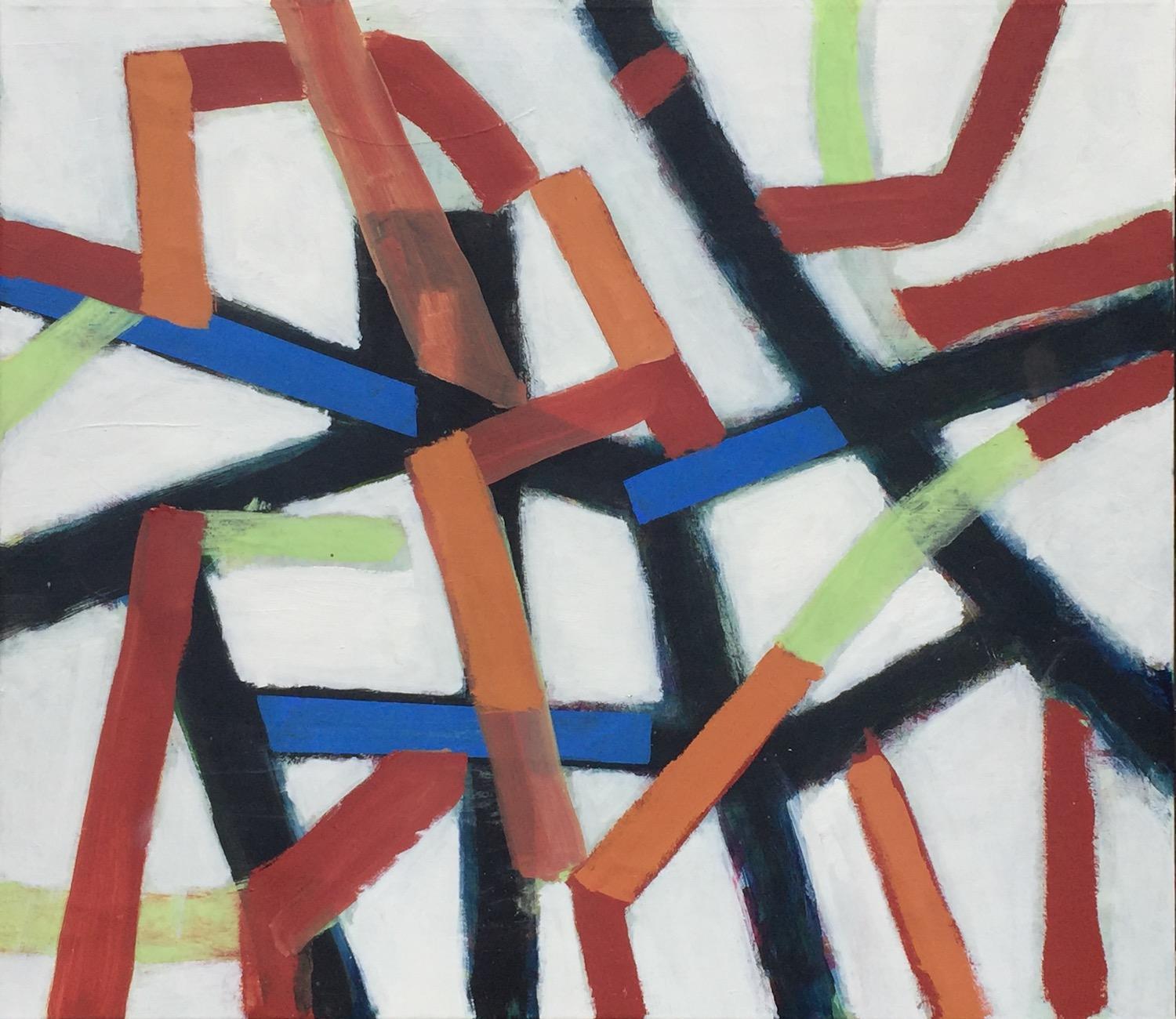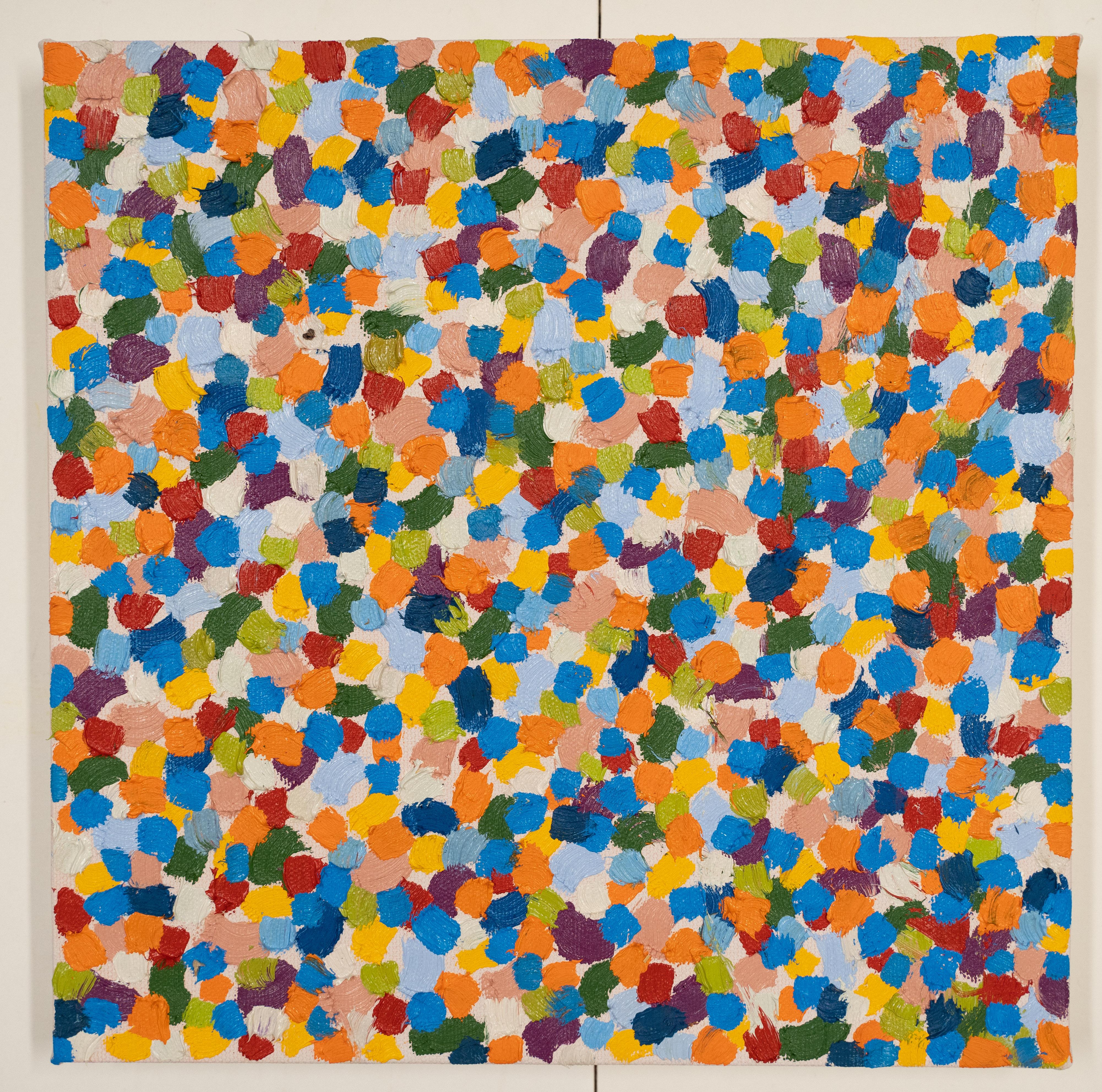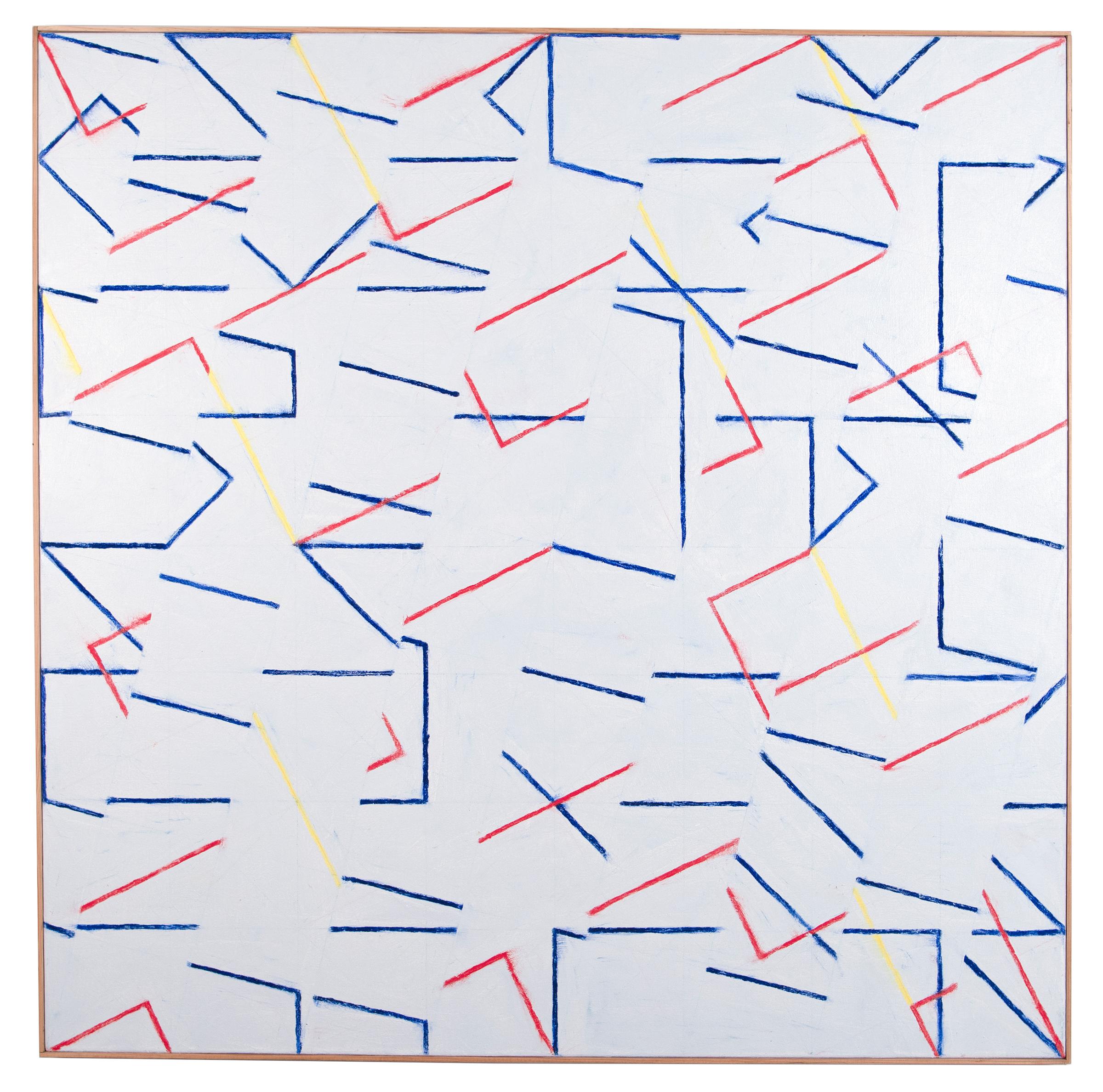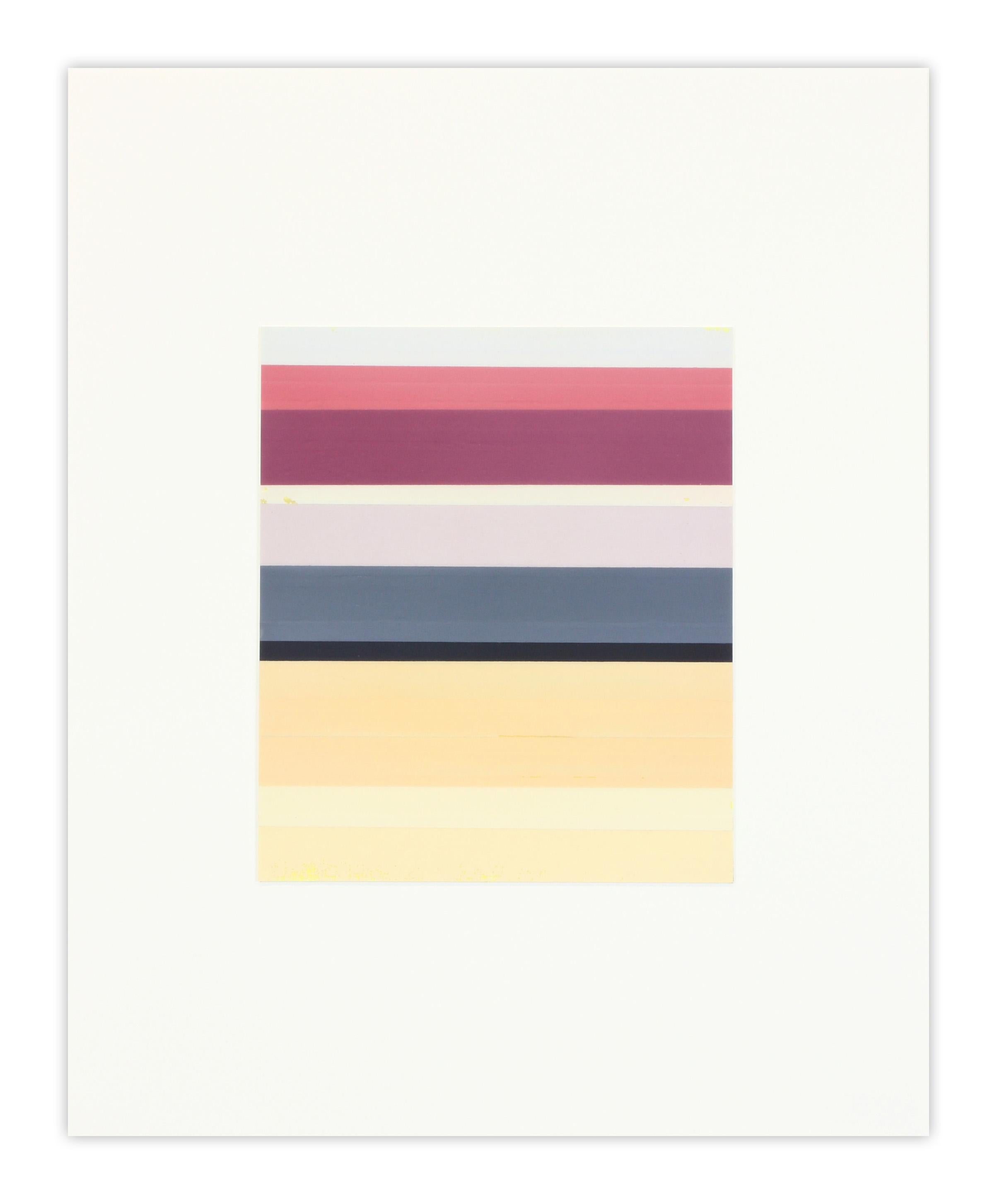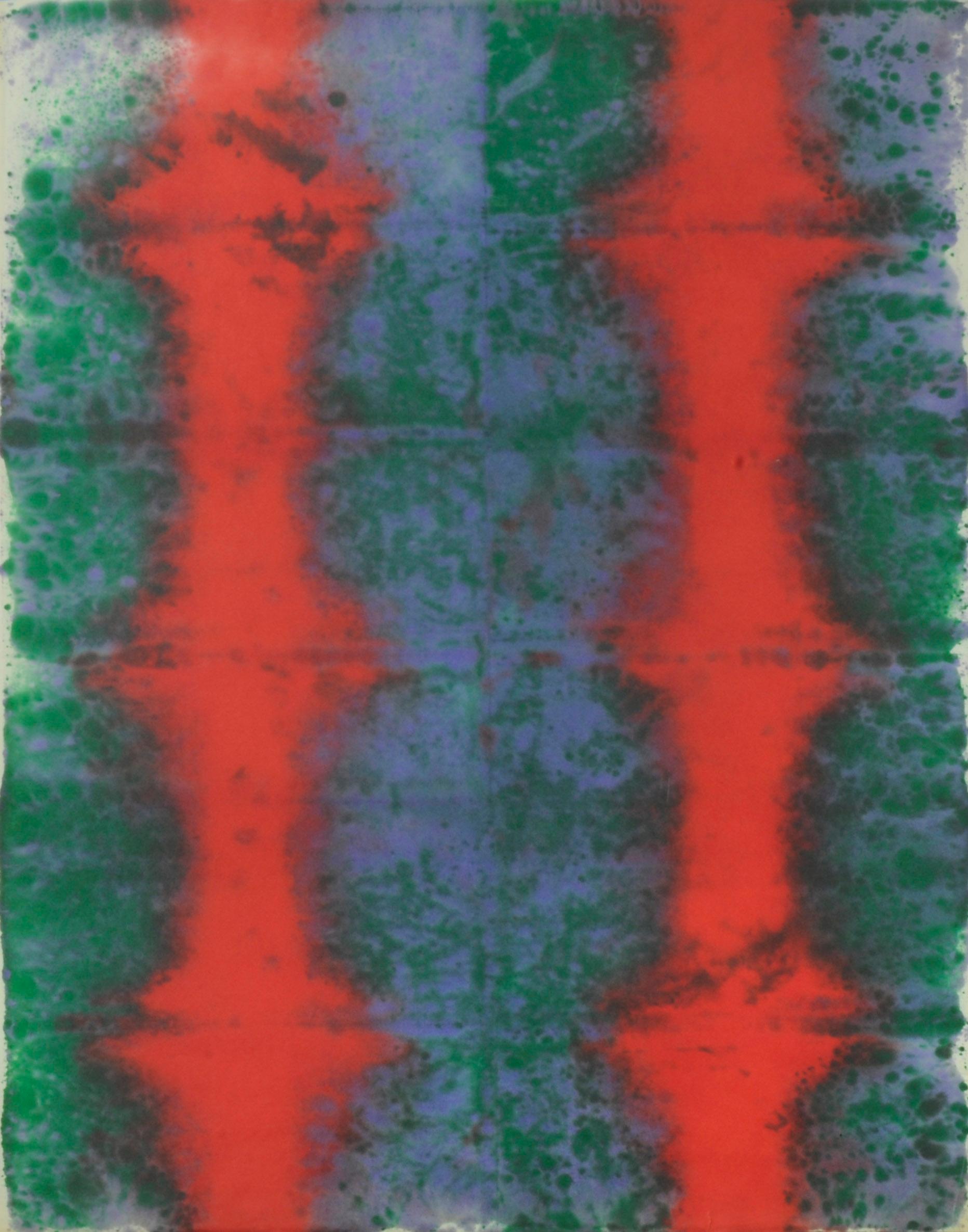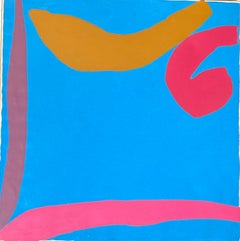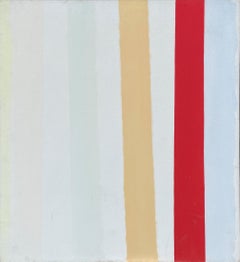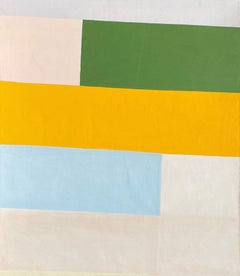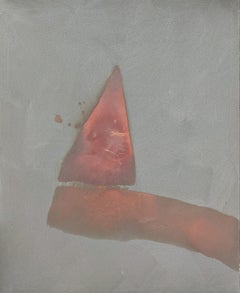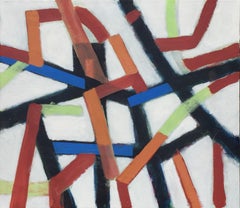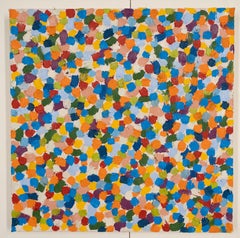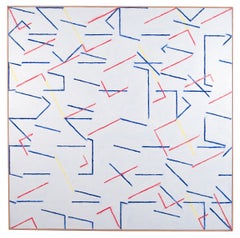Items Similar to "Eleven Thirteen, (Dancing Line Series)" Elliott Thompson, Color Field Work
Want more images or videos?
Request additional images or videos from the seller
1 of 4
Elliott Thompson"Eleven Thirteen, (Dancing Line Series)" Elliott Thompson, Color Field Work1972
1972
$16,000
$20,00020% Off
£12,189.34
£15,236.6820% Off
€13,910.92
€17,388.6520% Off
CA$22,483.79
CA$28,104.7320% Off
A$24,503.37
A$30,629.2120% Off
CHF 12,975.59
CHF 16,219.4920% Off
MX$294,311.29
MX$367,889.1120% Off
NOK 164,273.86
NOK 205,342.3220% Off
SEK 151,033.65
SEK 188,792.0720% Off
DKK 103,899.17
DKK 129,873.9720% Off
About the Item
Elliott Thompson
Eleven Thirteen, (Dancing Line Series), 1972
Signed, Elliott Thompson, dated, 2/72, and inscribed, Eleven Thirteen, on verso and again on stretcher
Acrylic on canvas
44 x 63 inches
Elliott Thompson’s career as an artist spanned more than six decades but only from about 1965 to 1980 was he at the center of the art world. In that period, he was one of the painters clustered around Washington, DC who rejected the painterly forms of abstract expressionism. Instead, he preferred impersonal hard-edged shapes on monochromatic fields that reinforced the flatness of the picture surface. Thompson’s work at this time represents some of the finest examples of this style that flourished during the 1960s and 1970s.
Thompson was born in Newport, Rhode Island in 1912 but he grew up in Washington, D.C. and spent most of his life in the area. He possessed a Scandinavian heritage and a middle-class background but he was only a mediocre student and dropped out of Briarly Hall Military Academy (Poolesville, MD) without a diploma. From 1929 to 1933, he joined the Navy and sailed the world through the worst part of the Great Depression.
After his enlistment ended in the Navy, Thompson worked at a variety of government jobs that eventually turned into a civil service career. While employed by the U.S. government, he took classes and received a BA in accounting from Ben Franklin University (later George Washington University). In 1939, he took a job with the Bureau of the Budget and for the next 20 years existed in a world of numbers and budgets. Meanwhile, Thompson’s personal life was in turmoil. He struggled with alcohol addiction and three failed marriages.
From 1953 to 1957, he lived in Paris while still working for the U.S. government. The five-year stay inspired him with a love for French culture and become an artist. Although he had never painted seriously, Thompson began studying art in Montparnasse in Paris at André Lhote’s academy. Thompson studied directly with Lhote, a Cubist painter who had an excellent reputation as a teacher. At this point, Thompson was still a part-time painter, concentrating on figurative scenes and still lifes.
In 1967, Thompson was 55 years old and there was no particular reason to predict a stellar artistic career for him. However, he now had more than 30 years of service with the federal government, and so was eligible for retirement. He decided to give up his position as a financial officer in the Supply and Maintenance Agency of the U.S. Army, and devoted himself to art on a full-time basis.
That same year, he began studying with Roy Slade at the Corcoran School of the Arts and Design, the school associated with the Corcoran Gallery of Art. Thompson made rapid progress with his painting. He abandoned realistic subject matter for non-figurative art and switched from oils to acrylics, lured by their faster drying time. He soon joined the faculty of the Corcoran and began exhibiting his geometric abstract canvases. By the 1970s, the long-time bureaucrat had become a critically acclaimed artist.
Even in his first efforts, Thompson’s approached painting as a kind of problem in measurement and organization, as befitting a man who had worked with numbers his entire life. His earliest paintings from 1967 to 1969 were based on the division of a square, mostly in black and white, or just white on raw canvas. Many of them were neat abstractions of repetitious forms assembled on a grid. A critic at one of his exhibitions described his work as “mathematical and sequential, formal, disciplined, austere.” Even when he began introducing color into his canvases in 1971, he continued to focus on pattern and repetition.
Thompson displayed his art in several group and solo shows from the late 1960s through the early 1990s. Between 1969 and 1973, his most prolific period, he had regular exhibitions at the Jefferson Place Gallery, a noted supporter of Washington Color School artists. In 1974, the Corcoran Gallery of Art presented a retrospective exhibit of his work, affirming his meteoric rise.
Because Thompson lived in Washington, DC at the time, he was often linked with members of the Washington Color School such as Gene Davis, Thomas Downing, Paul Reed, and Howard Mehring. In some ways, he did not fit comfortably in this category. Thompson came late to the movement and his earliest geometric abstracts were in black and white, eschewing color.
But Thompson did adopt a consciously impersonal approach to paint application. There was an absence of visible brushstrokes in Thompson’s work, and an emphasis on sharp composition. Each area was clearly defined. Instead of the broad gestures and the emotional mysticism so prized by abstract expressionists, Thompson emphasized formal elements such as lines and shapes. He never tired of this approach. In 1979, he began a major series of hard-edged geometric canvases based on the trapezoidal form.
However, by 1980, the aesthetic of hard-edged abstraction had fallen out of fashion among art critics. That year, one critic reviewed one of Thompson’s gallery shows by noting that Thompson “had with dogged loyalty remained true to his straight edge, his masking tape, his panels of flat, well-chosen colors.” Though he had only been painting seriously for 13 years, he was already 68 years old. Unlike many painters, he had never staked his life on an art career. Fame meant little to him. A fourth marriage in 1983 to a woman 38 years younger was a happy distraction. From 1984 to 1987, he lived and painted in a small village in southern France but his desire to paint or teach gradually faded away. In 1987, the couple returned to the United States and moved to northern Virginia. He gradually drifted into obscurity, dying in 2016 at age 103.
Elliott Thompson’s career as an artist spanned more than five decades but only from about 1965 to 1980 was he at the center of the art world. His hard-edge geometric abstracts were precise, impersonal, and devoid of almost any reference to the outside world. His best canvases offered viewers a meditative space where form, color, line, scale, and texture were almost all that mattered. He did not shine for long but he shined brightly.
- Creator:Elliott Thompson (1912 - 2016, American)
- Creation Year:1972
- Dimensions:Height: 44 in (111.76 cm)Width: 63 in (160.02 cm)
- Medium:
- Movement & Style:
- Period:
- Condition:
- Gallery Location:New York, NY
- Reference Number:1stDibs: LU1841211696842
About the Seller
5.0
Platinum Seller
Premium sellers with a 4.7+ rating and 24-hour response times
Established in 2022
1stDibs seller since 2022
132 sales on 1stDibs
Typical response time: <1 hour
- ShippingRetrieving quote...Shipping from: New York, NY
- Return Policy
More From This Seller
View All"Untitled" Ray Parker, Color Field Lyrical Abstract, Blue and Magenta Painting
Located in New York, NY
Ray Parker
Untitled, 1969
Signed and dated on the reverse
Oil on canvas
32 x 32 inches
Provenance
Private Collection, New York
Ray Parker was born in 1922 in South Dakota. After c...
Category
1960s Color-Field Abstract Paintings
Materials
Canvas, Oil
$23,600 Sale Price
20% Off
"A Stripe" Calvert Coggeshall, Abstract Expressionism, Hard-edge Vertical Lines
Located in New York, NY
Calvert Coggeshall
A Stripe, 1971
Signed, titled, and dated on the reverse
Acrylic on canvas
30 x 30 inches
Calvert Coggeshall worked as an abstrac...
Category
1970s Abstract Expressionist Abstract Paintings
Materials
Canvas, Acrylic
"Untitled" Calvert Coggeshall, Abstract Expressionism Hard-edge Stripes
Located in New York, NY
Calvert Coggeshall
Untitled, circa 1975
Oil on canvas
50 x 40 inches
Calvert Coggeshall worked as an abstract painter and interior designer primari...
Category
1970s Abstract Expressionist Abstract Paintings
Materials
Canvas, Acrylic
"Untitled, " Daniel Lergon, German Contemporary Abstract Painting
Located in New York, NY
Daniel Lergon (German, b. 1978)
Untitled, 2012
Oil on canvas
47 1/2 x 39 1/2 inches
Signed and dated on the reverse
Provenance:
Galerie Christian Lether...
Category
2010s Contemporary Abstract Paintings
Materials
Canvas, Oil
"Untitled, " Jay Rosenblum, Hard-Edge Color Field, Colorful Horizontal Stripes
By Jay Rosenblum
Located in New York, NY
Jay Rosenblum (1933 - 1989)
Untitled, 1973
Acrylic on canvas
54 x 128 inches
Signed twice and dated on the reverse
Provenance:
Private Collection, Long Island
Jay Rosenblum experim...
Category
1970s Hard-Edge Abstract Paintings
Materials
Canvas, Oil, Acrylic
$60,000 Sale Price
25% Off
"Untitled" James Suzuki, Abstract Color Field Composition, Mid-Century
By James Suzuki
Located in New York, NY
James Suzuki
Untitled, circa 1960
Signed lower right "Suzuki"
Acrylic on canvas
66 1/4 x 80 inches
Provenance:
Private Collection, New Jersey
James Hiroshi Suzuki...
Category
1960s Color-Field Abstract Paintings
Materials
Canvas, Oil
$17,600 Sale Price
20% Off
You May Also Like
Line Control, Chromatic Collision Series, Abstract Geometric Line Painting
By Robert Petrick
Located in Los Angeles, CA
Robert Petrick's "Line Control" is a fusion of meticulous geometry and bold abstract expression. From the artist's Chromatic Collisions series, this piece is both timeless and contem...
Category
21st Century and Contemporary Abstract Geometric Abstract Paintings
Materials
Oil, Linen
Gradient X, Abstract Minimalist Colorfield Acrylic Painting by Jay Rosenblum
By Jay Rosenblum
Located in Long Island City, NY
This acrylic painting on paper was created by New York-born artist Jay Rosenblum. In his art, he seeks to correlate his great love for chamber music sonatas with freely evolving bloc...
Category
1970s Abstract Abstract Paintings
Materials
Paper, Acrylic
Untitled 8. From Ritmos abstractos (Abstract Rhythms) Series
Located in Miami Beach, FL
"Ritmos Abstratos" invites us to explore the visual universe of the artist Juan Carlos Amador, who, through his unique perspective, translates the pulsations of space and the invisi...
Category
2010s Abstract Geometric Abstract Paintings
Materials
Canvas, Oil
Losing Ground
By Power Boothe
Located in Branford, CT
POWER BOOTHE known internationally for his ground breaking minimalist abstraction.
Works in the collection of the Whitney Museum, Wadsworth Atheneum, Guggenheim Museum and others.
EXHIBITIONS AND PRODUCTIONS
Minimalist Aesthetic, group exhibition, Wadsworth Atheneum Museum of
Art, Hartford, CT
New Work, Hostetler Gallery, group exhibition, Nantucket, MA
Infinite Connections, group exhibition, ArtSpace Torrington, Torrington,
CT 2011
Power Boothe: Out of Order, solo exhibition, New Britain Museum of American Art, New Britain, CT
Excavating New Ground: American Art in the 1970s, group exhibition,
University of Virginia Art Museum, Charlottesville, VA 2008
American Abstract Artists Exhibition, group exhibition, The Painting Center, New York, NY
Interspace: Line and Color, three-person exhibition, Washington Art Association, Washington Depot, CT
1999
Columbia Festival of the Arts, solo exhibition, Columbia MD
New Work, group exhibition at Goya-Girl Press, Baltimore, MD Twenty-Third Annual National Invitational Drawing Exhibition, Emporia
State University, Emporia, KS 1998
New Prints Published by Goya-Girl Press, group exhibition, Baltimore MD
The Fanelli Show, O.K. Harris Gallery, NY
Chance + Necessity, Goya-Girl Press, Baltimore, MD
Tilted Arc, set design, Doug Verone Dance Co., Joyce Theater, NY
1997
Investigations, four-person exhibition, Goya-Girl Press, Baltimore, MD Abstract Index, group exhibition, Condeso/Lawler Gallery, NY
Made at the Mill, group exhibition of prints, Goya-Girl Press, Baltimore,
MD
Art Without Curves, 1120 Gallery, Phoenix, AZ
TEN WAYS, group exhibition Milan, Italy and in Bonn Germany POWER BOOTHE, New Work Hostetler Gallery, group exhibition, Nantucket, MA
Power Boothe: Paintings, solo exhibition, EBK Gallery (small works), Hartford, CT
Borderline, solo exhibition, Five Points Gallery, Torrington, CT
New Work Hostetler Gallery, group exhibition, Nantucket, MA
Rhythm and Repetition in 20th Century Art, group exhibition, Heckscher
Museum of Art, Huntington, NY
For Leo, group exhibition, Sideshow Gallery, Brooklyn, NY
75th American Abstract Artists Print Portfolio, group exhibitions at: Martin
Gallery, Allentown, PA
New Work, Hostetler Gallery, group exhibition, Nantucket, MA
Breaking Boundaries, group exhibition, Atlantic Center for the Arts, New Smyrna Beach, FL
Painted Black, OIA group exhibition, New York Law School Gallery, NY 1996
American Abstract Artists 1936–1996, Mishkin Gallery, NY
American Abstract Artists, 60th Anniversary Exhibition, Kean College Art
Gallery, NJ and Westbeth Gallery, NY Small Works, Stephen Haller Gallery, NY
1995
Power Boothe, solo exhibition, Stephen Haller Gallery, NY
Small Works, group exhibition, Stephen Haller Gallery, NY Scratching the Surface, group exhibition, Stephen Haller Gallery, NY
1994
The Persistence of Abstraction, group exhibition, Noyes Museum, Ocean
Park, NJ
Maryland Institute, Then and Now, traveling exhibition, Josiah White
Center, Jim Thorp, PA, Anita Shapolsky Gallery, NY
Between the Sexes, group exhibition, Maryland Art Place, Baltimore, MD New Performances in Found Spaces, exhibition of drawings and
photographs of set designs, Lincoln Center Library, NY
Our Town, set design for dance production, choreographed by Emily
Keeler, music by Richard Beggs, Oakland Ballet, Premiere Paramount
Theater, Oakland, CA
Set in Motion, New York State Council selection of films, Lincoln Center,
Walter Reade Theater, NY 1993
Inaugural Show, group exhibition, The Painting Center, NY Recent Painting and Sculpture, group exhibition, Robert Morrison
Gallery, NY
Private Lives, group exhibition of artists who make films, Zooma Gallery,
NY
Ring Around the Rosie, set design for dance/theater production in
collaboration with David Parsons, music by Richard Peaslee, lighting
by Michael Chyboski, Premiere Hancher Auditorium, Iowa City, IA Thicker Than Water, set design for dance production, choreographed by
Stephan Koplowitz, music by Scott Killian, Premiere Dance Theater
Workshop, NY
The Devil Comes to Princeton, set design for theater production, text by
Mac Wellman, directed by Beth Schachter, Premiere Princeton
University, Princeton, NJ 1992
Recent Paintings, solo exhibition, Robert Morrison Gallery, NY Drawings, solo exhibition, Lewiston Aubern College Gallery, Lewiston,
ME
Action, group exhibition, Trenkmann Gallery, NY
A Momentary Order, set design for dance/theater production in
collaboration with Doug Varone, choreographer, music by C. Hyams
Hart, costume design by Lynne Steincamp, Premiere Lewiston, ME Short Shorts, film showing, Thread Waxing Building Space, NY
1991
Paintings and Drawings, solo exhibition, Dance Theater Workshop
Gallery, NY
Recent Paintings, solo exhibition, Trenkmann Gallery, NY Group Show, Robert Morrison Gallery, NY
Interactions, group exhibition, Institute for Contemporary Art, Philadelphia, PA
Once and Once, director, designer, filmmaker for theater/film production in collaboration with Keely Garfield, choreographer and C. Hyams Hart, composer, Premiere Dance Theater Workshop, NY
Five Films, film showing, Dance Theater Workshop, NY
Garden Party, set design for dance production by Claire Porter, Premiere
Dance Theater Workshop, NY
Intimate and Not So Intimate, set design for dance production,
choreographed by Blondell Cummings, Premiere St. Marks Dance
Space, NY 1990
New Paintings, solo exhibition, Time Life Building, NY
Paintings and Photographs, two-person exhibition, Schick Art Gallery,
Skidmore College, Saratoga Springs, NY
30 Stories, set design, theater production by Ain Gordon, Premiere P.S.
122, NY
Cartoon, set design, dance production choreographed by Keely Garfield,
Premiere Dance Theater Workshop, NY
Ringer Pike, co-director and set design, multimedia stage production by
Dale Worsley, Premiere Hall Walls, Buffalo, NY
Dinizulu and His African Dancers and Singers, set design for video
production by Skip Blumberg, NY 1989
Recent Work, solo exhibition, Souyun Yi Gallery, NY
New Painting, solo exhibition, The Harrison Gallery, Boca Raton, FL Restructure/Subtracting the Grid, group show, New Jersey Center for
Visual Arts, Summit, NJ
Set Drawings for Modern Dance, group exhibition, Harvard Theater
Collection, Cambridge, MA
Postcards, set design for video production by Mark Rappaport, NY Quad, set design for video, dance production by Samuel Becket, Global
Village Production, NY
Moon, film premiere, Equitable Center Theater, Whitney Museum, NY Film/Video Arts Angel Award Showcase, film showing, Museum of
Broadcasting, NY 1988
Paintings: 1971–1988, solo exhibition, Hurlbutt Gallery, Greenwich, CT Recent Paintings, solo exhibition, PMW Gallery, Stamford, CT Drawings for Sets and Films, solo exhibition, Dance Theater Workshop
Gallery, NY
Wilderness, director, designer, filmmaker for theater/film production in
collaboration with Catlin Cobb, choreographer, Stephen Fechter,
writer, A. Leroy, composer, Premiere Dance Theater Workshop, NY The Joys and Enigmas of a Strange Hour, set design, Dance Theater
Workshop, NY 1987
New Paintings, solo exhibition, painting, Souyun Yi Gallery, NY Boothe and Zetterstrom, two-person exhibition, drawing, Almquist
Gallery, New Preston, CT
Twenty Summers Past, group exhibition, Colorado Springs Fine Arts
Center, Colorado Springs, CO
House Keeping, set design for dance production in collaboration with
Catlin Cobb, choreographer, Premiere Dance Theater Workshop, NY
The Event of the Year, set design for dance production choreographed by Emily Keeler for Jacques d’Amboise’s National Dance Institute, Premiere San Francisco Opera House, CA
Keeping up with the Eighties, set design for theater production in collaboration with Michael Smith and A. Leroy, Premiere Dance Theater Workshop, NY
Beside Herself, 16mm film, Premiere Performance Space 122, NY Our Man, 16mm film, Premiere Dance Theater Workshop, NY Films by Artists, group film showing, White Columns Gallery, NY Naked Eye Cinema, group film showing, Zone Gallery, NY
Art Mix 87, film showing, Avenue B, NY 1986
New Paintings, solo exhibition, Lynn Mayhew Gallery, Ohio Wesleyan University, Delaware, OH
Drawings and Notations for Post-Modern Dance, group exhibition, Harvard University Theater Collection, Cambridge, MA
Low Tide, set design for dance production, Catlin Cobb, choreographer, Premiere Dance Theater Workshop, NY
Transparent Means for Traveling Light, set design for dance production in collaboration with David Gordon, John Cage, composer, Premiere Loeb Theater, Harvard University, Cambridge, MA and Brooklyn Academy of Music, NY
Overture, 16mm film, Premiere Dance Theater Workshop, NY New Film Works, group film showing, curated by Amy Taubin, The
Kitchen, NY
Avant Garde Arama, group film showing, Performance Space 122, NY
1984
Currents, solo exhibition, Institute for Contemporary Art, Boston, MA Modern Art, group exhibition, selected by John Yau, Ted Greenwald
Gallery, NY
Illusion in Contemporary Art, group exhibition, Trompe L’Oeil Gallery, NY 8 in ’84, group exhibition, Ronald Feldman Gallery, NY
Framework, set design for dance production, in collaboration with David
Gordon, choreographer, Premiere Dance Theater Workshop, NY and
Loeb Theater, Harvard University, Cambridge, MA
Variety Show, set design for dance production in collaboration with
choreographer Charles Moulton and composer A. Leroy, Premiere
Dance Theater Workshop, NY
And So and Also, 16mm film, Premiere The Collective for Living Cinema,
NY
New Filmmakers, group film showing, San Francisco Cinemateque, San
Francisco, CA 1983
Paintings: 1973 to 1983, solo exhibition, Climenhaga Fine Arts Center, Grantham, PA
Subtleties, group exhibition, painting, Sutton Gallery NY
Art and Dance, group exhibition, Institute for Contemporary Art, Boston,
MA
Group Exhibition, A.M. Sachs Gallery, NY
Dance Environments, set design and performance in collaboration with
contemporary choreographers, Premiere Institute for Art and Urban
Resources, P.S. 1, Queens, NY
Bill Loman Master Salesman, set design for video production in
collaboration with Michael Smith, Premiere The Kitchen, NY
The Mother of Us All, set design for musical by Gertrude Stein and Virgil Thomson, directed by Stanley Silverman, Premiere Saint Clement’s Theater, NY
Phantom Limbs, set design for theater production directed by Gitta Honninger, Theater of the Open Eye, NY
1982
New Paintings, solo exhibition, A.M. Sachs Gallery, NY
Navigation Series, solo exhibition, Dance Theater Workshop Gallery, NY Trying Times, set design for dance production in collaboration with David
Gordon, Premiere Dance Theater Workshop, NY
Step Wise Motion, set design for dance production, choreographed by
Charles Moulton, Premiere Dance Theater Workshop, NY
It Starts at Home, set design for theater production in collaboration with
Michael Smith, Whitney Museum, NY
Film Works, group film showing selected by Amy Taubin, The Kitchen,
NY 1981
New Paintings, solo exhibition, A.M. Sachs Gallery, NY
Transitions, group exhibition, Summit Art Gallery, Summit, NJ Drawings, group exhibition, The Art Gallery, University of Nebraska,
Omaha, NE
Bridge Dance, set design for dance production by Meg Eginton,
Premiere Dance Theater Workshop, NY 1980
The Cold Eye, set design for film by Babette Mangolte, NY 1979
The Language of Abstraction, group exhibition, Betty Parsons Gallery, NY
Group Exhibition, A.M. Sachs Gallery, NY 1978
Recent Paintings, solo exhibition, A.M. Sachs Gallery, NY
Group Exhibition, A.M. Sachs Gallery, NY 1977
Private Images, group exhibition, Los Angeles County Museum of Art, Los Angeles, CA
Collectors’ Choice X, group exhibition, McNay Art Institute, San Antonio, TX
Painting, group exhibition, P.S. 1, Institute for Urban Resources, Queens, NY
Book-Objects by Contemporary Artists, Albright Knox Art Gallery, Buffalo, NY
Group Exhibition, A.M. Sachs Gallery, NY 1976
Recent Paintings, solo exhibition, A.M. Sachs Gallery, NY
Books, two-person exhibition, Franklin Furnace Gallery, NY
Rooms, group installations, Institute for Art and Urban Resources, P.S.
1, Queens, NY
Gallery Artists, group exhibition, A.M. Sachs Gallery, NY
Southern Exposure, set design for theater production by Mabou Mines
Theater Group, directed by Joanne Akalaitis, Premiere Performing
Garage, NY 1975
Collectors’ Choice V, group exhibition, Philbrook Art Center, Tulsa, OK Recent Acquisitions, group exhibition and traveling exhibition, Solomon R.
Guggenheim Museum, NY
PUBLIC COLLECTIONS
Center Gallery, NY
Elephant Steps, set design for musical theater production by Richard
Foreman and Stanley Silverman, Premiere, Tanglewood, Lenox, MA
Baltimore Museum of Art, MD
The British Museum, UK
Brooklyn Museum of Art, NY
Climenhaga Fine Arts Center, PA
Colby College Museum of Art, ME
Colorado Springs Fine Art Center, CO
Fogg Museum, Harvard University, MA
Joel & Lila Harnett Print Study Center, University of Richmond Museum, VA
Harvard University Museums, MA Heckscher Museum of Art, Huntington, NY Hunterdon Museum of Art, NJ
Kennedy Museum, OH
Lehman Brothers Kuhn Loeb, Inc., NY Metropolitan Museum of Art, NY Mississippi Museum of Art, MS
Missoula Art Museum, MT
Museum of Fine Arts, Boston
Museum of Modern Art, NY
Painting Endures, group exhibition, selected by Dore Ashton, Institute of Contemporary Art, Boston, MA
Group Exhibition, A.M. Sachs Gallery, NY 1974
New Paintings, solo Exhibition, A.M. Sachs Gallery, NY
Group Exhibition, A.M. Sachs Gallery, NY
Art of This Decade, group exhibition, Solomon R. Guggenheim Museum,
NY
Victor, 16mm film, Premiere Collective for Living Cinema, NY
Glass Curtains, 16mm film, Premiere Collective for Living Cinema, NY
1973
Paintings, solo exhibition, A.M. Sachs Gallery, NY
Group Exhibition, A.M. Sachs Gallery, NY
Art for Acquisition, group exhibition, Rhode Island School of Design
Museum, Providence, RI
Jim, 16mm film, Premiere Collective for Living Cinema, NY Match, 16mm film, Premiere Collective for Living Cinema, NY
1972
Recent Work, group exhibition, Art and Urban Resources, NY Group Exhibition, A.M. Sachs Gallery, NY
1971
New Talent, group exhibition, A.M. Sachs Gallery, NY
Ten Young Artists, group exhibition, Solomon R. Guggenheim Museum,
NY 1970
Red Horse Animation, set design for theater production by Mabou Mines, directed by Lee Breur, Premiere Guggenheim Museum, NY
1968
Painting and Sculpture, group show, Whitney Museum, Art Resources
PRIVATE COLLECTIONS (SELECTED)
Muscarelle Museum of Art, The College of William and Mary, Williamsburg, VA
New Britain Museum of American Art, CT
New Jersey State Museum, Trenton, NJ
Parrish Art Museum, Southampton, NY
Princeton University Library, NJ
Solomon R. Guggenheim Museum, NY
Stanford University Art Museum, CA
University of Virginia Art Museum, Charlottesville, VA Wadsworth Atheneum Museum of Art, CT Weatherspoon Art Gallery, NY
Whitney Museum of American Art, NY
Blackstone Group
Bloomingdale’s, NY
Chase Manhattan Bank, NY
Christophe DeMenil Collection, TX
Colorado College Collection, CO
Deloitte Haskins and Sells, NY
Design Unit Collection, NY
Edgar Tobin Aerial Surveys Collection, IL Edward Carpenter Collection, CT
Estee Lauder Corporation, NY
General Electric Corporation Collection, NY Howard and Roberta Miller Collection, CT Lehman Brothers Kuhn Loeb Collection, Inc., NY New York Bank for Savings, NY
Philip Morris Companies Collection, Inc., NY Patrick J. Waide Collection, NY
John F. Saladino Collection, Inc., NY
Sony Corporation Collection, NY
Trump Collection, NY
Walter and Linda Wick Collection, CT
Connecticut Art Education Association, Inc.
Scott Shuler Distinguished Art Advocate Award
GRANTS AND AWARDS 2009
2000
Andy Warhol Foundation Grant
For Art-Body-Mind: An Integration Symposium at Ohio University
1997
National Endowment for the Arts Inter-Media Grant
For multi-media dance project in collaboration with Doug Varone, Choreographer, and Lynne Steincamp, costume designer
1992
Lila Wallace-Reader’s Digest Grant
For Momentary Order, a multi-media dance project in collaboration with Doug Varone, choreographer, C. Hyams Hart, composer, and Lynne Steincamp, costume designer
ACADEMIC ADMINISTRATION AND TEACHING
1991
New York State Council on the Arts Grant
For Once and Once, a multimedia theater film collaboration with Keely Garfield, choreographer, and C. Hyams Hart, composer
1989
Pollock/Krasner Foundation Grant for painting Film Video Arts, Angel Award for film
1988
Maryland Institute Trustees Award for Teaching Excellence National Endowment for the Arts Inter-Arts Grant
For Wilderness, a multi-media theater/film collaboration Foundation for Contemporary Performance Art
Art Matters, Inc., Grant
1987
New York State Council on the Arts Grant
1986
New York State Council on the Arts Grant
For Transparent Means for Traveling Light, a collaboration with David Gordon and John Cage
Art Matters, Inc., Grant
Yaddo Fellow for painting and writing
New York State Council on the Arts Grant
Massachusetts Arts Council Grant
For Transparent Means for Traveling Light production at Loeb Theater
1985
John Simon Guggenheim Fellowship for painting
Asian Cultural Council Fellowship for independent study in Japan Just Above Midtown Production Grant
National Endowment for the Arts Inter-Arts Grant
For “Mike’s House,” a video production in collaboration with Michael Smith
1984
National Endowment for the Arts Inter-Arts Grant
For “Variety Show,” in collaboration with Charles Moulton Massachusetts Arts Council Grant, 1984
For “Framework,” a dance project in collaboration with David Gordon New York Art and Performance Award (Bessie Award)
New York State Council on the Arts Grant
For Trying Times, a dance project collaboration with David Gordon, choreographer
1982
Institute for Art and Urban Resources for one-year residency at P.S. 1
1976
National Endowment for the Arts, Artist Fellowship for painting
1971
Theodoran Award, Guggenheim Museum, for traveling exhibition, Ten Young Artists, purchase award
Hartford Art School, University of Hartford 2011 - present
Professor of Painting and Drawing
University of Hartford, 2001–2010 Dean, Hartford Art School
Ohio University, 1998–2001 Director, School of Art
Maryland Institute, College of Art, 1993–1998
Co-Director, Mt. Royal Graduate School, and Artist and Critic-in- Residence
Princeton University, 1988–1995
Lecturer in the Humanities, Visual Arts Program
School of Visual Arts, 1979–1988 Instructor
Colorado College, 1977
Director, Painting and Drawing Summer Program 2014-2015
Faculty Humanities Center Fellow, Lecture: Complexity and Art-making, University of Hartford Humanities Center Lecture Series, Spring 2015, Theme: Exploring Complexity
2008–2009
Chair, University of Hartford’s Academic Strategic Planning Committee
2007–2012
Delegate, Commission on Accreditation, National Association of Schools of Art and Design
2005–2012
Accreditation Chair, Evaluation Teams to assess schools for National
Association of Schools of Art and Design accreditation 2000
Director of Art-Body-Mind: An Integration, four-day symposium at Ohio University
¬Presenters: Mark Johnson, Lewis Hyde, Ellen Dissanayake, Joseph Caroll, Brian Hansen, Nancy Aiken and others
1998
Curator of Chance + Necessity, a painting exhibition at Maryland Art Place (MAP)
¬Wrote catalogue essay
1986–1998
Co-Director (with composer, Dick Connette) of Present Company, Inc.,
Not-for-Profit Production Company in New York, NY to produce original theater and film projects
¬Produced two-multi-media theater events and five independent short films
¬Designed sets for Obie Award-winning off-Broadway theater productions, including Richard Foreman’s Ontological Hysteric Theater and Mabou Mines theater company
¬Designed sets for dance productions in collaboration with choreographers, including Doug Varone, Dave Gordon, and David Parsons, and with composers Virgil Thompson, Philip Glass, and Dick Connett
GRANT PANELS AND JURIES 2015
¬Art directed and designed film productions, including Michael Snow, Mark Rappaport, Babette Mangold and Richard Foreman, resulting national awards
¬ Production design and art direction for many videos, including Cyndi Lauper, Dion, and Jean Luc Ponty, resulting in international video awards
Juror, Abstraction Exhibition, Colorado Sprints Art Center, Colorado Springs, NY
Panel, Five Points Gallery, Torrington, CT
Juror, Colorado Springs Arts Center, CO
2014
Juror, Mystic Art Center, Mystic Seaport, CT
2010
Juror, Alliance for Young Artists, NY Juror, ArtSpace. Hartford, CT
2009
Juror, ArtSpace. Hartford, CT
Juror, West Hartford Art League, CT
2006
Juror, Mystic Art Center, Mystic Seaport, CT Juror, Silvermine Art Center, CT
2004
Juror, West Hartford Art League, CT
2002
Juror, Exhibition, Gallery on the Green, Canton, CT
1999
Freedom of Speech in the Arts, Panel at Ohio University, OH
1997
Fulbright Committee, Maryland Institute College of Art, MD Juror for 7th Annual Pennsylvania Juried Exhibition, PA
1994
National Endowment, Presenting and Commissioning Program, Washington, DC
1991
New York State Council for the Arts, Film Panel, NY
1989
National Endowment for the Arts, Inter-Arts Panel, Washington, DC
1986
National Endowment for the Arts, Inter-Arts Panel, Washington, DC
VISITING ARTIST AND LECTURER 2015
Lecture on Abstraction, Colorado Springs Arts Center, Colorado Springs, CO
Lecture on Abstraction, Worthington Historical Society, Worthington Corners, Worthington, MA
2014
Mystic Art Center, Mystic Seaport, CT
Workshop on Composition; Workshop on Value and Color 2010-11
New Britain Museum of American Art, New Britain, CT
Five lectures titled: “Art Matters” 2010
Wadsworth Atheneum, Hartford, CT
Connecticut Art Education Association 2007
Wadsworth Atheneum, Hartford, CT
West Hartford Art League, West Hartford, CT 2005
Virginia Commonwealth University, Richmond, VA 2002
Wadsworth Atheneum, Hartford, CT
Center for Art and Culture, Aix-en-Provence, France 1999
University of Minnesota, MN
Emporia University, KS
Columbia Festival for the Arts, Columbia, MD
St. Mary’s College of Maryland, St Mary’s City, MD
1977
Elizabethtown College, Elizabethtown, PA Kennedy Center, Washington, DC
1995
Pennsylvania Academy of Art, Philadelphia, PA The Cooper Union, New York, NY
Florida State University, Tallahassee, FL
1994
Arizona State University, Tempe, AZ Messiah College, Grantham, PA
1991
Trinity College, Hartford, CT
Institute for Contemporary Art, Philadelphia, PA
1990
Bard College, Annandale-on-Hudson, NY
Maryland Art Institute, College of Art, Baltimore, MD
1987
San Francisco Art Institute, San Francisco, CA
1986
Ohio Wesleyan University, Delaware, OH
1984
Film/Video International, Castle Hill, MA
1982
Rutgers College, New Brunswick, NJ
1978
Pratt Institute, New York, NY
1976
Maryland Institute, College of Art, Baltimore, MD
EDUCATION
Colorado College, BA, 1969; Honorary Doctorate of Arts, 1989
PROFESSIONAL MEMBERSHIPS 2005–PRESENT
1998–PRESENT 1986–PRESENT 1983–PRESENT
PUBLICATIONS
Whitney Museum Independent Study Program, 1967–1968 American School of Classical Studies in Athens, Greece, 1990
Post-graduate research in classical archeology University of California at Berkeley, CA, 1996
Post-graduate research associate in philosophy and cognitive studies
Wadsworth Atheneum, Board (serve on the Education Committee) National Association of Schools of Art and Design
College Art Association
American Abstract Artists
“Chance + Necessity,” Catalog Essay for Chance and Necessity, an Exhibition of Abstract Painting, MAP Publication, 1998.
“Out of Balance, A Study of Mondrian’s Dynamic Equilibrium Concept,” American Abstract Artists Journal, NO. 2, AAA Publications, 1996. “Notes on Abstract/Meaning,” American Abstract Artists Journal, No. I,
AAA Publications, 1996.
“On Painting,” Meaning, Volume II. Segue Foundation, 1987. “When the Fourth Soldier Falls, A Study of Piero Della Francisca’s
Resurrection,” Issue, Volume 6, Reflex Horizons, Ltd., 1986.
BIBLIOGRAPHY
Acocella, Joan, “Power Boothe on Two Edges,” The Village Voice,
February 20-26, 1991, review with photo.
_____, Joan, “New York Reviews,” Dance Magazine, September 1988,
review with photo.
Ashton, Dore, American Art Since 1945 (Oxford University Press), 1982,
pages 159-160, with photo.
_____, “Power Boothe’s Gait,” Arts Magazine, June 1981, article with
photos.
_____, “Painting Endures,” Institute of Contemporary Art, Boston, 1975,
catalogue with photo.
Baker, Kenneth, “Inauspicious Content in a New ICA Form,” Boston
Phoenix, May 17, 1975, review.
Bannon, Anthony, “Members Gallery, Albright Knox,” Buffalo Evening
News, April 15, 1977, review.
Bell, Jane, Arts Magazine, January 1974, review with photo.
Betz, Margaret, “Power Boothe (A.M. Sachs),” Art News, May 1976,
review with photo.
Burnside, Madeleine, “Power Boothe (A.M. Sachs),” Art News,
December 1977, review with photo.
Catlin, Roger, “Power Boothe’s Work Rises Out of ‘Order’, Hartford Courant,
January 30, 2011.
Commanday, Robert, “Effective Vision in Oakland,” San Francisco Chronicle, September 24, 1994.
Dieckman, Katherine, “Film Noir et Blanc,” Village Voice, February 10, 1987, review.
Dunning, Jennifer, “Symbolism by Power Boothe,” New York Times, March 17, 1991, review.
_____, “Out in the Proving Grounds, Times Get Tougher,” New York Times, May 26, 1991, article.
Edelman, Robert G., “Power Boothe at Stephen Haller,” Art in America, May 1996, review with photo.
Ellenzweig, Allen, “Power Boothe,” Arts Magazine, May 1976, review with photo.
_____, “Power Boothe,” Arts Magazine, December 1977, review with photo.
Everingham, Carol J., “Power Boothe’s Abstract Musical Figures in Paint,” The Advocate and Greenwich Time, November 1988, review with photo.
Foster, Hal, Artforum, December 1977, review with photo.
Frank, Peter, “Power Boothe (A.M. Sachs),” Art News, January 1975,
review with photo.
Haggerty, Gerard, “Power Boothe, Ron Ehrlich...
Category
2010s Abstract Geometric Abstract Paintings
Materials
Oil
P073 (Abstract Painting)
Located in London, GB
This series is composed entirely of masking tape recycled from the artist's Oil on Paper paintings. Arranged to form new compositions, the strips carry a direct color history, as the...
Category
2010s Abstract Abstract Paintings
Materials
Paper, Tape, Oil, Acrylic
Untitled
By Laddie John Dill
Located in Fairlawn, OH
Untitled
Watercolor on paper. 1971
Unsigned
Sheet size: 24 x 19 inches
Condition: Excellent
From the collection of Ileana Sonnabend (1914-2007)
Laddie John Dill, a Los Angeles artist...
Category
1970s Abstract Abstract Drawings and Watercolors
Materials
Watercolor
More Ways To Browse
Paul Thomas
Washington Color School
Thomas Davis
Reed Thomas
Red And Orange Painting
San Miguel De Allende
Contour Art
Tufts University
Blue Abstract Flowers
40 X 40 Painting
Contemporary Dot Painting
Notre Dame Cathedral
Expressionist Floral Paintings
Dior 1984
Palm Desert Art
Seal Painting
Chocolate Art
Ochre Painting
